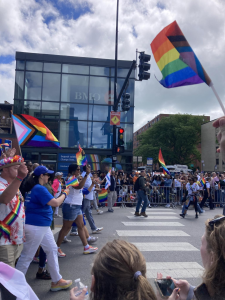Gun Safety: School Shooting Raises Questions Once Again
March 1, 2018
I wrote previously in our last issue about people’s right to conceal and carry a gun. Within a week, another mass school shooting occurred. Within a week, another 17 people died.
19-year-old Nikolas Cruz opened fire at Marjory Stoneman Douglas High School in Parkland, Florida., his former high school, on Feb. 14.
As the community grieves the loss of those 17 people, the country once again goes into a national debate on gun safety laws. The same issue that arises every time a deadly shooting occurs.
Despite its prevalence of those arguments, they seem to fall short every time. Most of the shootings don’t even make the news, showcasing how indifferent our society has become to this problem. Everytown for Gun Safety, an nonprofit organization that works to prevent gun violence, defines a school shooting as “any time a firearm discharges a live round inside a school building or on a school campus or grounds.”
But the mass shootings we see on television usually do not include most of these incidents, opting out to report on the suicides and accidentally fired guns, giving the audience a different perspective on how frequent these incidents occur .
For now, most of the focus is on the shootings that have the most casualties. The Washington Post reports that their statistics are based on incidents where at least four people died at the hands of a lone shooter, or two shooters in rare cases.
With these statistics in mind, the tally counting the victims of mass shootings began in 1966 when a student opened fire from a clocktower at the University of Texas, killing 17 people. Since then, the number of mass shooting victims has increased to 1,077.
At the center of the debate regarding gun safety, the type of gun used has been highly controversial. The Washington Post mentioned semi-automatic rifles as one of the most used assault weapons in mass shootings.
The AR-15, which was first used during the Vietnam War to replace the M-14 rifle due to its portability, has been present in some of the deadliest shootings in the U. S. This includes the Route 91 Harvest country music festival in Las Vegas in 2017, where 58 people died, and the elementary school shooting in Newtown, Connecticut., where 26 people lost their lives, 20 of them children.
The popularity of the AR-15 has increased since the federal ban on assault weapons expired in 2004. According to an article from CNBC, The National Rifle Association reports that the AR-15 is the “most popular rifle in America,” and 8 million of them are owned in the U.S.
The NRA also attributes the popularity to its versatile uses including sports shooting and hunting. But if the gun is made to be used for these purposes, why are shooters turning to them?
Dean Hazen, owner of The Gun Experts in Mahomet, Illinois., and a master firearms instructor believes that it is because of the reputation it has developed through other mass shootings and a copycat mentality.
Hazen believes mass shooters are often not knowledgeable regarding guns, therefore they tend to use what has been used before. “Thank God they don’t know any better because if they did they would use much more effective weapons,” Hazen said.
It is this copycat mentality that has led to five arrests in the week after the shooting. According to Time Magazine, one of those arrested was as young as 11-years-old.
The idea that Stoneman Douglas has been influencing others who might act on those same thoughts is disheartening and extremely alarming. We cannot control people’s thoughts, but we can control their access to semi-automatic rifles and pistols, and also put in place stricter gun laws that allow for screening and safety precautions.
In Florida, an AR-15 could be bought by anyone with a clean record who is over the age of 18 with no wait period, making it an easier purchase than a handgun.
Not having a waiting period, or any other set federal standards on gun purchases is a deadly mistake on our government’s part. Leaving the decision to the states to implement gun legislature leaves for a huge divide in the country’s security. According to Giffords Law Center to Prevent Gun Violence, only eight states have a assault weapons ban. Other states only limit the number of magazines that can be purchased at one time or their capacity.
We need a federal law that is implemented across the country that set the same standards for anyone who wants to make a purchase. A waiting period, a background check and a mental evaluation should be routine.
Also, implemented nationwide should be what are known as “extreme risk protection orders.” These court warrants, currently used in only five states, allow for people to make court requests to judges to order the removal of firearms from someone who is believed to be dangerous.
With the survivors of Stoneman Douglas leading the country in the discussion of gun laws in the U.S., what is important for those who turn a deaf ear to understand is that stricter gun laws do not take away the 2nd Amendment. While there are those who believe guns should be banned, a more reasonable solution would be stricter laws limiting the access to those who would pose a threat.
With survivors of the devastating attack claiming that they will be the last mass shooting in the U.S., I hope politicians finally pay attention since they failed to do anything after the other 149 shootings.





